To get a low-end estimate of your gas line repair cost, multiply the length of your gas line in linear foot by $15. To get a high-end estimate, multiply the length by $25.
Gas line length in linear foot x $15 = low-end price of gas line repair
Gas line length in linear foot x $25 = high-end price of gas line repair
This estimate already takes the labor fee into account, which can be $45 to as much as $1,500 an hour.
But be aware that this can differ based on the pipe materials, the gas line issue, and your location.
So, if you’d like to know more about the costs of gas line repair, we made this guide for you. It will delve more into the prices and if DIY repair is sensible, among other things.
What are the different types of gas line repair?
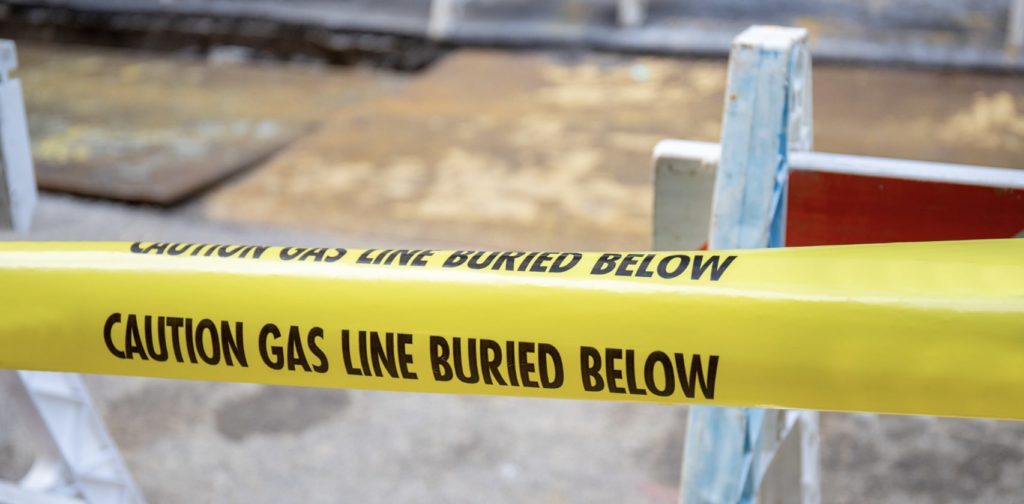
Below are the main types of gas line repair that can be done for you and their average costs:
Gas Leak Repair
Generally, letting a gasfitter fix a standard gas leak costs around $120 to $250, but the costs can escalate depending on the situation.
For instance, if the leaky gas pipe is located behind a wall or crawlspace. Because removing the drywall may be required, you can expect to pay higher between $270 and $760.
But if the gas lines are totally buried under the ground, landscaping and excavation work will be needed, which will considerably bring up the price. The estimated cost for this is $1,500 to $5,000.
Gas leaks coming from your appliances are dangerous. Being very unstable in the air, it can suddenly cause a fire, explosion, or gas poisoning to harm families and their pets.
How do you know whether the gas has leaked out to the inside of your home? See if you can detect a rotten egg or sulfuric smell—no matter how slight or pungent.
If you can, then the best thing to do would be to evacuate everyone at the house, head out of it yourself, and quickly contact the gas company for help.
Gas Line Capping
Gas line capping often costs $75 to $150 to do.
Capping your gas line can either mean that all or a certain section of your gas pipes won’t be used.
Probably, it’s because you’re upgrading to an electric medium and so, are no longer using the gas company’s service.
It’s important to cap unneeded gas lines because this will help to protect against the alarming incidence of gas leaks.
Gas Line Replacement
The estimated cost for gas line replacement is between $120 and $1,350 same as installing a new gas line and a top-up of $6 to $7 per linear foot for dismantling the damaged lines.
Due to problems like wear and tear to earthquakes, your gas pipe system can partially or entirely be corroded or damaged.
In these events, the gas supply pipes would have to be replaced; otherwise, they won’t function well, or worse, the gas can leak out.
Gas Pipe Inspection
The average cost of a professional gas inspection is $150.
To ensure that your gas line is functioning optimally all the time, you have to get it regularly inspected every year.
This way pros can find out if there’s a potential issue such as if the gas tubes are rusting and loosening from the other pipes, which would need to be promptly repaired.
Pressure Inspection
Generally, most clients pay plumbers or gasfitters approximately $75 to $100 for completing this task.
Inspecting the pressure of the gas line is needed to be done in order to maintain the safety and efficient operation of your appliance and house.
Gas contractors have a standard for this: a gas line working at 0.5 pounds per square inch gauge (psig) must be able to take on 5 psig for 30 minutes.
What are the different gas pipe materials available?
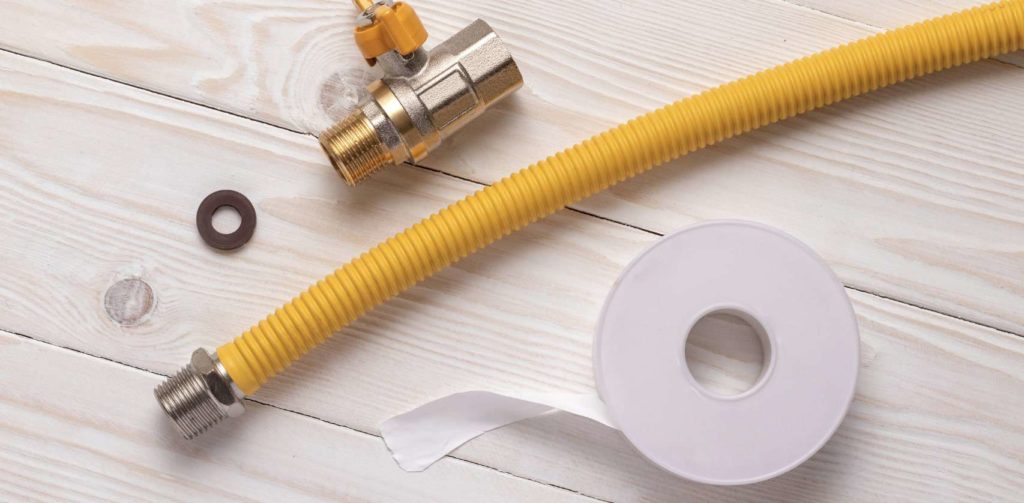
As we have mentioned earlier, one of the big cost factors of gas line repair is the pipe material used. So, here are the various types of gas pipes and their costs:
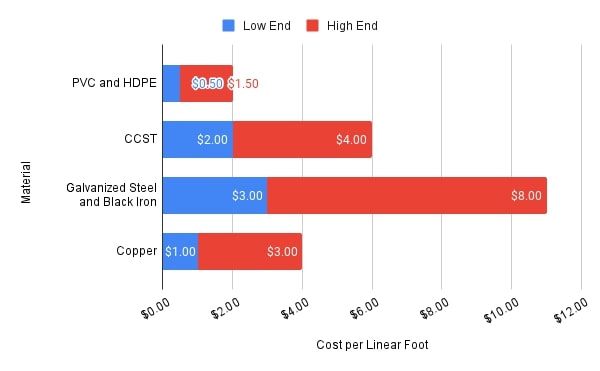
1) Polyvinyl Chloride and High-Density Polyethylene
These gas pipe materials are only specialized for use underground. So even though, they’re affordable, costing just $0.50 to $1.50 per linear foot, they’re not always an option for homeowners.
Both of them have a variety of benefits, namely:
- Polyvinyl Chloride (PVC)
- Made of plastic
- Lightweight
- Corrosion-proof
- Resistant to chemical and bacterial buildup
- Affordable
- High-Density Polyethylene (HDPE)
- Fantastic durability
- UV-resistant
- Resistant to most chemicals
- Not prone to leaching or chemical leaks
- Affordable
- Eco-friendly
2) Flexible Corrugated Stainless Steel
Compared to the first option of PVC and HDPE, flexible corrugated stainless steel gas lines (CCST) cost higher to install at $2 to $4 per linear foot.
CCST connects stably and conveniently to easy and hard-to-access places alike. So that makes them a great substitute for hard pipes and complex appliance pipe routes in your house.
3) Galvanized Steel and Black Iron
Both of these piping materials fetch a steeper price of $3 to $8 for every linear foot since they’re a lot harder to install than the other types mentioned.
These are the two types of steel (galvanized and black iron) for transporting natural gas or liquid to a home or business.
Galvanized pipes are costlier than black iron to get due to their protective zinc coating and their production process.
On the other hand, black iron is uncoated and appears dark in color due to the iron-oxide formation that developed during the manufacturing process.
But black iron pipes are relatively stronger and safer because they were produced with no seams, unlike their galvanized counterparts. They’re also the most commonly used pipe material.
Also, it’s not recommended to use galvanized pipes for your gas line because, over time, they can shed flakes which can, in turn, clog the burner unit and gas regulator.
4) Copper
Copper gas lines have a good price tag of $1 to $3 per linear foot and can be a great choice.
To this day, a lot of people use copper gas tubing for its durability, light weight, and flame resistance. Gas and water flow easily in copper pipes, and the thinnest ones are actually great to use.
However, some areas prohibit the use of copper lines for safety and compliance reasons.
What are the costs of gas line repair by US City?

Here is a graph comparing the price variances of gas line repair in different US cities.
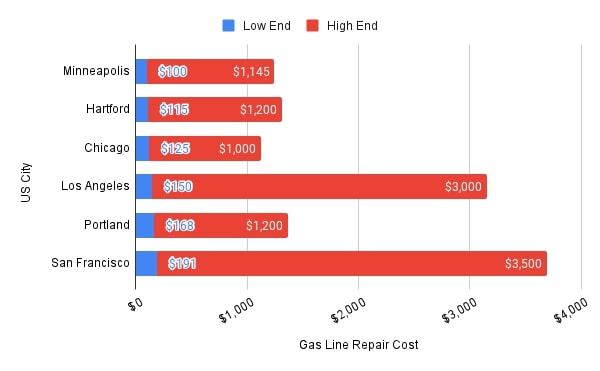
Almost always, urban-area gas contractors charge higher prices for gas line repair than rural area ones because of the cost of living there.
So, it follows from this that you’ll need more budget to spare for major cities. But if you live in a small town or village, you can expect to spend lower on gas line repair.
Can I repair my house’s gas line myself?

Although you can do it, gas line repair is a sensitive job that’s best left to the professionals.
Not repairing or installing the pipes properly will leave you with a fire or health risk. In fact, gas leak fires and explosions killed 41 people in 2020, according to The Guardian.
So, whether your gas line has a small or big issue, you won’t go wrong calling a licensed and experienced gasfitter or gas plumber.
While you’ll pay a handsome price, you’ll have great peace of mind that everyone in your home is safe and sound.
FAQs about Gas Line Repair
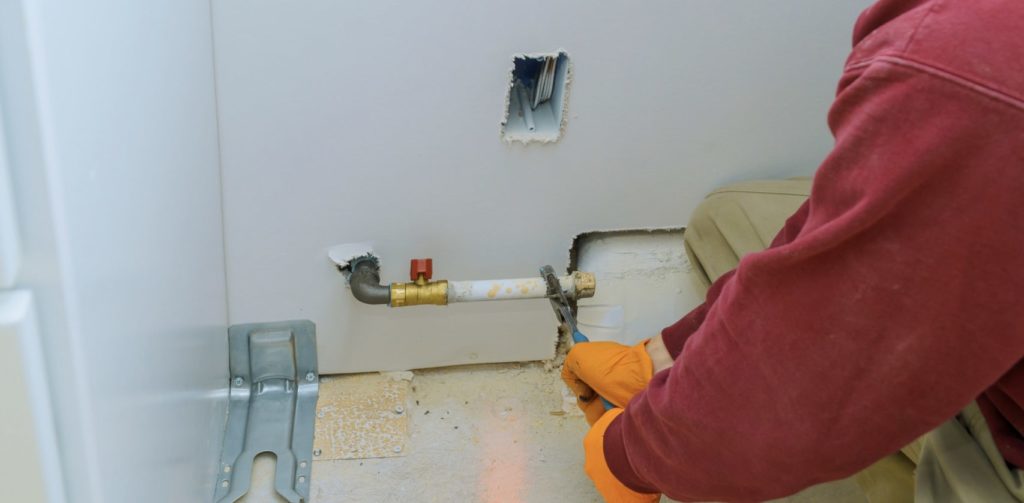
- What are the gas appliances at home?
Many house appliances run on gas, including stoves, furnaces, fireplaces, dryers, water heaters, and barbecue grills.
A lot of people still prefer them over electric ones because they heat up instantly and natural gas is a lighter-priced energy source than them.
- Which part of the pipe does gas leak occur from?
Typically, natural gas leaks out from the joint portion of the riser, shut-off valve, tee union, and even flexible pipes.
So, if you suspect the joint part has corroded or it hasn’t gotten its deserved yearly inspection for quite some time, we recommend that you have it done by a pro very soon.
- How fast do I have to repair a gas leak?
As soon as you verify a gas leak, you have to quickly get everyone out of the house, contact a gas plumber, and let them diagnose and fix the issue.
Speaking of which, the telltale signs of a gas leak are the following: a rotten egg smell, a hissing sound, cracked pipes, and lower gas energy output. The sign can also be as mysteriously inconspicuous as getting a higher power bill at month’s end.
- How long will gas line repair take?
A minor gas line issue—for instance, gas pipe rerouting or capping—would only take about one to two hours to repair.
But for large leaks and if you have inaccessible pipes, the work may require drywall removal and excavation. So, everything will take around two to five days to finish.
- How far down are gas lines buried?
In most US locations, gas lines must be buried at least 2 feet underground.
Worry not, though, as your chosen tradesman will check with the local governing agency before any gas-system-related work is to be done to ensure that yours complies with modern codes.
You can also remind them to do that just to be on the safe side, so you’ll know exactly how they’re doing the gas line repair work.




